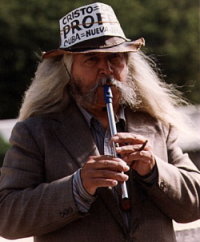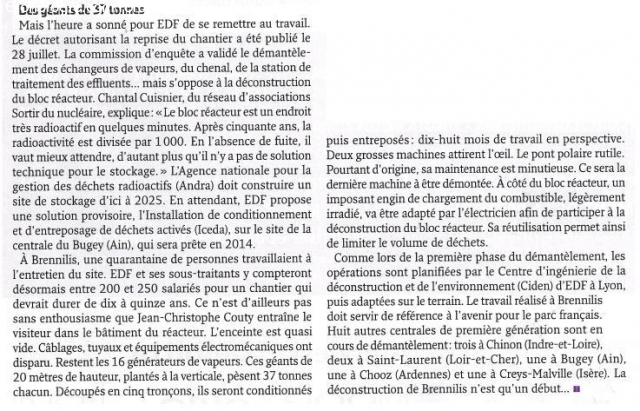Chooz A, full-scale nuclear dismantling test.
It is one of the first experiences of its kind in Europe, which will enter a decisive phase
lesechos.be August 10, 2010.
In the French Ardennes, a stone's throw from the Belgian border, the Chooz B nuclear power plant continues to produce electricity. That of Chooz A, on the other hand, is being dismantled. It was one of the first experiments of this type in Europe, all the more important since the Chooz A reactor, operated from 1967 to 1991, was of the same type as those currently in operation in France and Belgium.
Thanks to this full-scale test, EDF officials hope to refine their strategy to "deconstruct", as they prefer to say, the 58 French reactors in operation. Because of the extension of the power plants or not, nuclear reactors end up reaching retirement age: in the European Union, alongside the 145 reactors still operational, 74 are already closed.
Even if Electrabel had drawing rights on this power station, it is not associated with the dismantling process, which is the exclusive responsibility of the operator, EDF.
Around a hundred people, mostly subcontractors, work on the site, which is set up in a network of caves, on the hill overlooking the Meuse, instead of the classic concrete buildings of other nuclear power plants. The places show their age, with old-fashioned locker rooms where a sign forbids not only to eat, but also "to urinate and defecate".
To enter the nuclear zone, you have to strip naked, put on gloves, shoes, cap and special suit, and equip yourself with an oxygen system and a Geiger counter. A secure airlock provides access to the galleries, where the air pressure is kept lower than normal, to avoid any leakage in the event of an incident.
The uranium that was used as fuel was evacuated, and the circuits drained. Most of the cables, piping or pumps that could be removed were removed. Painted signals distinguish the different categories of material: blue = no danger, green = radioactive, red = must remain. When radioactive material is cut, hermetic airlocks are installed, in which men work in ventilated suits.
Despite all these precautions, the French nuclear safety authority, ASN, which regularly carries out inspections, is critical of the way in which the work is carried out. "ASN expects greater rigor from the licensee, in particular in the field of radiation protection where several significant events were declared during 2009", she wrote in its latest annual report. And in a letter of February 23, she mentions "several deviations" noted by its inspectors and calls for corrective measures.
"We take maximum precautions, and we have never had any incident," says Pascal Dziopa, works director at Chooz A. As soon as a situation does not correspond to what was planned, the workers are instructed to 'stop, and further investigations are being carried out. "
By the end of the year, the site will enter a decisive phase, with the dismantling of the four steam generators of devices of several tens of tons each, which will be soaked in a chemical bath to try to reduce their radioactivity, a first which, if successful, will reduce the tonnage of highly radioactive waste to be stored by the same amount.
Then, it will be the most delicate, the reactor vessel, a job that EDF will entrust to the Americans of Westinghouse, who originally supplied the machine.
EDF, which manages the entire French nuclear fleet, has opted for "immediate deconstruction" - even if the process takes 25 to 30 years. Other countries, such as the Netherlands or the Czech Republic, have chosen to postpone operations for several decades to benefit from the natural decrease in radioactivity. "We want to avoid passing on this problem to future generations, and benefit from the knowledge of those who installed these reactors", explains Alain Ensuque, director of Ciden, the engineering center created by EDF to manage the dismantling of its power plants, which employs 550 people, including around twenty in Chooz A. The testimony of these nuclear pioneers, now at least sixty years old, can be invaluable, while the documents on the way in which the plant was built are not always classified very effectively. EDF also stresses that the experience acquired during decommissioning can improve the design and maintenance of new power plants.
The French energy company refuses to communicate precisely on the costs of dismantling plant by plant. It indicates a total cost of 2 billion euros for the nine reactors currently in the "deconstruction" phase although the work at Brennilis, in Finistère, would have already cost 482 million while the most delicate phase has not yet started. "The first power stations are more expensive to deconstruct, because we are carrying out research there which will benefit the following ones", argues Ensuque.
These nine plants will produce nearly one million tonnes of waste, of which more than 80% is conventional waste. Of the remaining 185.000 tonnes, the weakest radioactive waste is sent to Morvilliers and Soulaines (Aube). The others will wait at the Bugey power plant site in Ain for Andra, the authority in this area, to open a final storage site.






